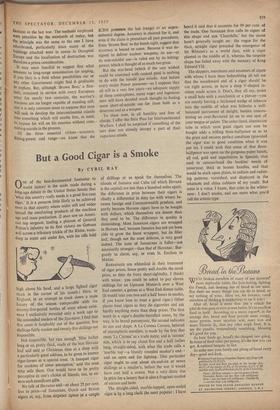But a Good Cigar is a Smoke
By CYRIL RAY
ONE of the best-documented footnotes to world history is the aside made during a long-ago debate in the United States Senate that what this country really needs is a good five-cent cigar.' It is a panacea little likely to be achieved even in that country where wider still and wider spread the comforting products of the machine age and mass production. (I once saw an Ameri- can top sergeant, leading a platoon of General Patton's infantry to its first victory on German soil across a tributary trickle of the Rhine, waist- deep in water and under fire, with his rifle held
high above his head, and a large, lighted cigar stuck in the corner of his mouth.) Here, in England, in an attempt to track down a male luxury of the season comparable with the seventy-five-pound bottles of scent whose exist- ence I exclusively revealed only a week ago to the astounded readers of the Spectator, I find that five cents is laughably out of the question, five shillings fairly modest and twenty-five shillings not impossible.
Not impossible, but rare enough. Nine inches long or so, pretty thick, made of the best Havana leaf arid sold at Christmas time at a shop with a particularly good address, to be given to known cigar-lovers as a special treat. 'A banquet cigar for smokers of some perception,' said the man who sells them. One would have to be pretty perceptive in one's choice of friends, too, to en- sure such munificent gifts.
We talk of Havanas and—at about 25 per cent. less in price—of Jamaicans. Dutch and British cigars at, say, from sixpence apiece to a couple of shillings or so speak for themselves. The islands of Jamaica and Cuba (of which Havana is the capital) are less than a hundred miles apart; the difference in price between their cigars is chiefly a differential in duty (as with wines) be- tween foreign and Commonwealth produce, and partly because Havana cigars have to be bought with dollars, which themselves are dearer than they used to be. The difference in quality is diminishing. Most Jamaican cigars are wrapped in Havana leaf, because Jamaica has not yet been able to grow the finest wrappers, but its filler leaf, though not the most delicate, is very good indeed. The taste of Jamaicans is fuller—not necessarily stronger—than that of Havanas : Bur- gundy to claret, say, or even St. Emilion to Medoc.
Restaurants are whimsical in their treatment of cigar prices. Some pretty well double the retail price, as they do (very short-sightedly, I think) with wines : you could be asked to pay eleven shillings for an Upmann Monarch over a West • End counter, a guinea at a West End dinner-table. (It would take you two and a half hours to smoke, if you know how to treat a good cigar.) Other places treat cigars as they do cigarettes and ask hardly anything more than shop prices.,The first word in a cigar's double-barrelled name, by the way, is its brand patronymic, the second indicates its size and shape. A La Corona Corona, beloved of atmospheric novelists, is made by the firm that owns 'La Corona' as a trade name, and is 'corona' size, which is to say about five and a half inches long, straight-sided, with what the trade calls a `marble top'—a bluntly rounded smoker's end— and an open end for lighting. This particular cigar ought to cost about six-and-six or seven shillings at a retailer's; before the war it would have cost half a crown. Not a very dizzy rise in price for a luxury that is also a fragrant symbol
of success and taste. • The straight-sided, marble-topped, open-ended cigar is by a long chalk the most popular ; I have heard it said that it accounts for 99 per cent. of the trade. One Jamaican firm calls its cigars of this shape and size `Churchills,' but the name hasn't generally caught on : the vogue for the thick, straight cigar preceded the emergence of Sir Winston's as a world face, with a cigar planted in the middle of it, whereas the torpedo shape has faded away with the memory of King Edward VII.
The shippers, merchants and amateurs of cigars with whom I have been hobnobbing all tell me that the mouthward end of a cigar should be cut right across, or have a deep V-shaped in- cision made across it. Don't, they all say, make a small hole with a matchstick or a piercer—you are merely forcing a thickened wedge of tobacco into the middle of what was hitherto a well- balanced instrument of delight, besides concen- trating an over-flavoured jet on to one spot of your tongue or palate. The cedar-lined, aluminium tube in which most good cigars can now be bought adds a trifling three-halfpence or so to the price and ensures perfect condition (provided the cigar was in good condition when it was put in). I could wish that some of that three- halfpence was spent on the gorgeous paper bands, all red, gold and superlatives in Spanish, that used to cummerbund the bookies' weeds of yesteryear, thick as broom handles, and that would be stuck upon plates, in radiant and radiat- ing patterns, varnished, and displayed in the whatnots and china cabinets of my youth. But mine is a voice, I know, that cries in the wilder- ness: I don't smoke, and am more what you'd call the artistic type.






































 Previous page
Previous page